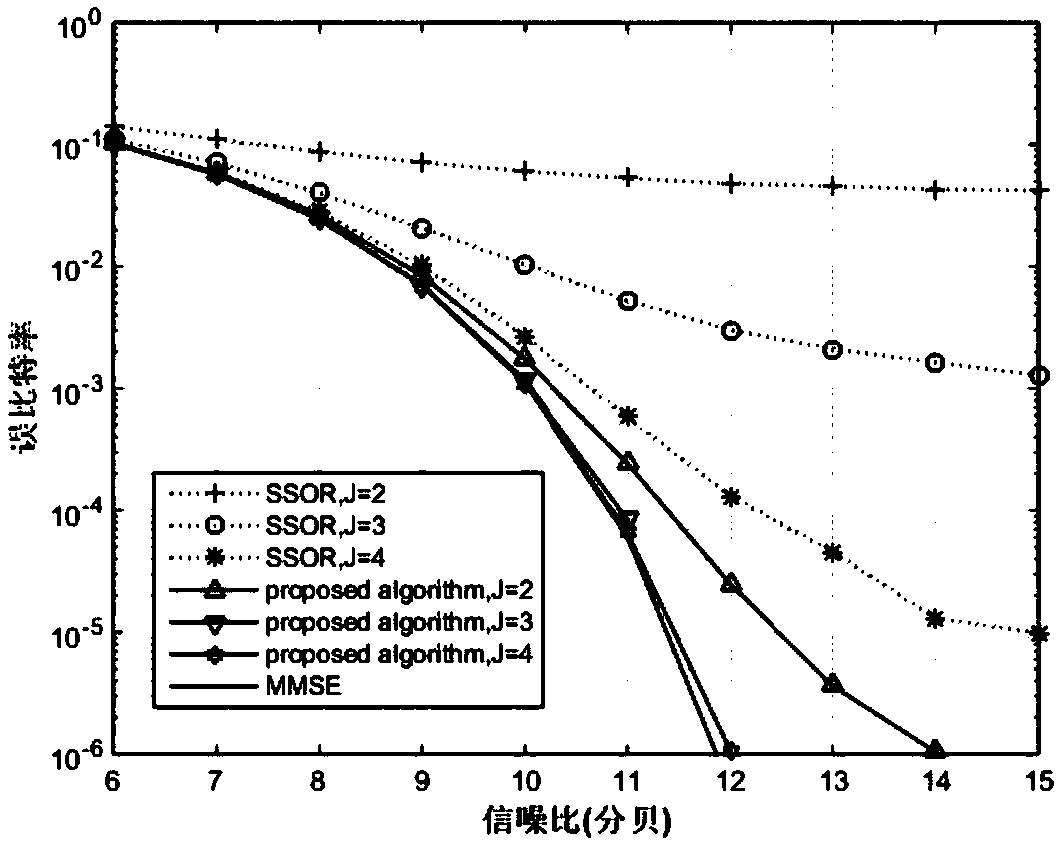Large-scale MIMO signal detection method based on Jacobi iteration
A signal detection, large-scale technology, applied in space transmission diversity, radio transmission system, electrical components, etc., can solve problems such as high computational complexity, achieve good iteration convergence, fast convergence rate, and reduce computational complexity.
- Summary
- Abstract
- Description
- Claims
- Application Information
AI Technical Summary
Problems solved by technology
Method used
Image
Examples
Embodiment 1
[0041] This embodiment provides a Jacobian-based iterative massive MIMO signal detection method, the method comprising:
[0042] Step 1: Construct the minimum mean square error detection MMSE detection matrix A according to the channel response matrix H;
[0043] Step 2: Decompose the detection matrix A according to A=D+E, wherein D represents the diagonal matrix of the detection matrix A, and E represents the off-diagonal matrix of the detection matrix A;
[0044] Step 3: Use the gradient algorithm to provide the search direction for the Jacobian algorithm, and obtain a hybrid iterative process of the Jacobian and the gradient algorithm;
[0045] Step 4: Improve the hybrid iterative process in step 3 by using the overall correction acceleration method to obtain the correction coefficient of the iterative equation, and then obtain the correction solution;
[0046] Step 5: According to the matrices A, D, E, gradient algorithm and overall correction acceleration method, the impro...
Embodiment 2
[0049] This embodiment provides a Jacobian-based iterative massive MIMO signal detection method, the method comprising:
[0050] Step 1: Construct the minimum mean square error detection MMSE detection matrix A according to the channel response matrix H;
[0051] Step 2: Decompose the detection matrix A according to A=D+E, wherein D represents the diagonal matrix of the detection matrix A, and E represents the off-diagonal matrix of the detection matrix A;
[0052] Step 3: Use the gradient algorithm to provide the search direction for the Jacobian algorithm, and obtain a hybrid iterative process of the Jacobian and the gradient algorithm;
[0053] Step 4: Improve the hybrid iterative process in step 3 by using the overall correction acceleration method to obtain the correction coefficient of the iterative equation, and then obtain the correction solution;
[0054] Step 5: According to the matrices A, D, E, gradient algorithm and overall correction acceleration method, the imp...
Embodiment 3
[0085] This embodiment provides a Jacobian-based iterative massive MIMO signal detection method, the method comprising:
[0086] Step 1: Construct the minimum mean square error detection MMSE detection matrix A according to the channel response matrix H;
[0087] Step 2: Decompose the detection matrix A according to A=D+E, wherein D represents the diagonal matrix of the detection matrix A, and E represents the off-diagonal matrix of the detection matrix A;
[0088] Step 3: Use the gradient algorithm to provide the search direction for the Jacobian algorithm, and obtain a hybrid iterative process of the Jacobian algorithm and the gradient algorithm;
[0089] Step 4: Use the overall correction acceleration method to improve the hybrid iterative process in step 3, obtain the correction coefficient of the iterative equation, and then obtain the correction solution;
[0090] Step 5: According to the matrices A, D, E, gradient algorithm and overall correction acceleration method, t...
PUM
 Login to View More
Login to View More Abstract
Description
Claims
Application Information
 Login to View More
Login to View More - R&D
- Intellectual Property
- Life Sciences
- Materials
- Tech Scout
- Unparalleled Data Quality
- Higher Quality Content
- 60% Fewer Hallucinations
Browse by: Latest US Patents, China's latest patents, Technical Efficacy Thesaurus, Application Domain, Technology Topic, Popular Technical Reports.
© 2025 PatSnap. All rights reserved.Legal|Privacy policy|Modern Slavery Act Transparency Statement|Sitemap|About US| Contact US: help@patsnap.com



